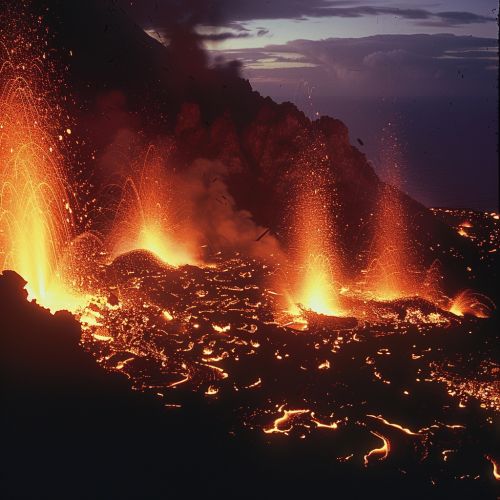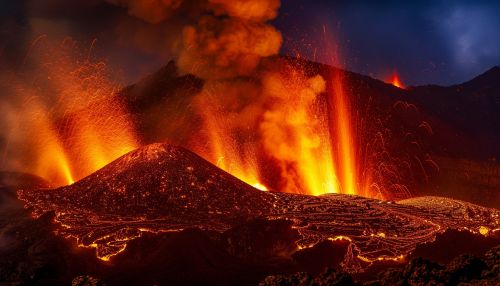Strombolian Eruption
Strombolian Eruption
A **Strombolian eruption** is a type of volcanic eruption characterized by the intermittent explosive bursts of basaltic lava. These eruptions are named after Stromboli, a volcano located off the coast of Italy, which has been erupting almost continuously for centuries. Strombolian eruptions are known for their relatively mild explosive activity, which can produce spectacular firework-like displays.


Characteristics
Strombolian eruptions are marked by the ejection of incandescent cinder, lapilli, and lava bombs. These eruptions typically occur at regular intervals ranging from minutes to hours. The eruptive activity is driven by the bursting of gas bubbles within the magma, which propels the molten rock into the air. The explosions are generally not powerful enough to cause significant damage to the volcano's structure.
The magma involved in Strombolian eruptions is typically basaltic or andesitic in composition, which means it has a low viscosity and allows gas to escape relatively easily. This results in the characteristic explosive bursts rather than a continuous flow of lava.
Mechanism
The mechanism behind Strombolian eruptions involves the ascent of gas-rich magma from the magma chamber to the surface. As the magma rises, the pressure decreases, allowing gas bubbles to expand. When these bubbles reach a critical size, they burst, causing an explosive release of gas and magma. This process is cyclical, leading to the periodic nature of Strombolian eruptions.
The gas involved in these eruptions is primarily composed of water vapor, carbon dioxide, and sulfur dioxide. The presence of these gases is crucial for the explosive activity, as they provide the necessary pressure to propel the magma out of the vent.
Products of Eruption
Strombolian eruptions produce a variety of volcanic materials, including:
- **Scoria**: Vesicular basaltic rock fragments that are ejected during the eruption.
- **Lava bombs**: Large, molten rock fragments that solidify as they fly through the air.
- **Lapilli**: Small, pea-sized rock fragments.
- **Volcanic ash**: Fine particles of pulverized rock and glass.
The ejected materials can accumulate around the vent, forming a cinder cone. These cones are typically steep-sided and composed of loose pyroclastic material.
Examples of Strombolian Eruptions
Apart from Stromboli, several other volcanoes exhibit Strombolian activity. Some notable examples include:
- **Mount Erebus** in Antarctica, which has been erupting continuously since 1972.
- **Mount Yasur** on Tanna Island in Vanuatu, known for its persistent Strombolian activity.
- **Parícutin** in Mexico, which emerged in a farmer's field in 1943 and erupted for nine years.
Hazards
While Strombolian eruptions are generally less hazardous than other types of volcanic eruptions, they can still pose significant risks. The primary hazards include:
- **Lava bombs and lapilli**: These can cause injury or damage to structures if they land in populated areas.
- **Volcanic ash**: Fine ash can cause respiratory problems and damage machinery.
- **Lava flows**: Although typically slow-moving, lava flows can destroy property and infrastructure.
Monitoring and Prediction
Monitoring Strombolian eruptions involves a combination of seismic, gas, and visual observations. Seismometers can detect the low-frequency tremors associated with gas bubble bursts, while gas sensors measure the concentration of volcanic gases. Visual observations, often aided by webcams, provide real-time information on eruptive activity.
Predicting Strombolian eruptions is challenging due to their intermittent nature. However, increased seismic activity and gas emissions can indicate an impending eruption.
